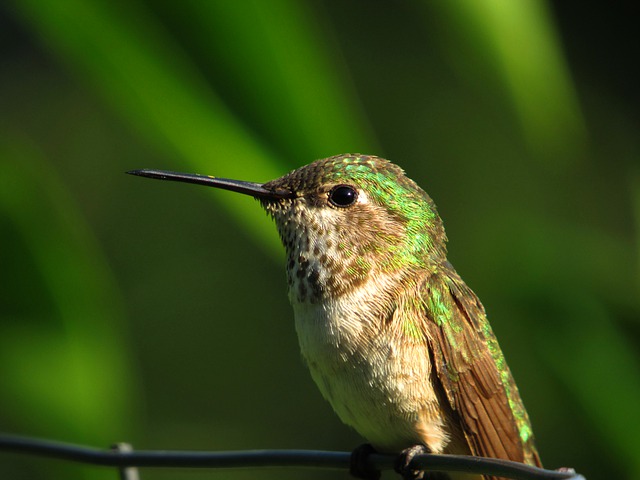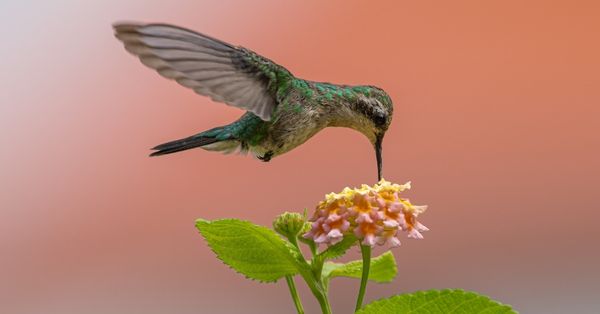Hummingbirds are undoubtedly one of the most fascinating and enchanting birds in the world.
Their tiny size, vibrant colors, and incredibly fast wings make them a favorite among bird enthusiasts and nature lovers alike.
But did you know that there are distinct differences between male and female hummingbirds that go beyond just their appearance?
In this article, we’ll delve into the unique characteristics of male and female hummingbirds, exploring their behaviors, mating habits, and more.
So, whether you’re an avid bird watcher or simply curious about these tiny creatures, prepare to be amazed by the incredible world of male vs. female hummingbirds.
Male vs Female Hummingbirds

The color, size, and gorgets of a male and female hummingbird are the three primary characteristics that set them apart from one another.
Female hummingbirds should be able to carry and lay eggs; hence, their bodies are somewhat bigger than those of males.
The male hummingbirds have more vivid and eye-catching colors than their female counterparts. Bright red, purple, pink, and green are some of the hues associated with males.
When opposed to males, the feathers of a female hummingbird often have a muted coloration, consisting of shades of dark green, brown, and white.
In conclusion, male hummingbirds have gorgets, which are brilliantly colored patches that are located on their chests.
The richest colors of the hummingbird’s plumage are incorporated into these gorgets, which are worn by males to entice the attention of females.
These are the most notable distinctions that can be found among male and female hummingbirds, and we’re going to go further into each of these aspects.
| Characteristic | Male Hummingbirds | Female Hummingbirds |
| Size | Smaller | Larger |
| Coloration | Brighter and more iridescent | Duller and less iridescent |
| Tail Feathers | Longer and more elaborate | Shorter and less elaborate |
| Gorget (throat feathers) | More colorful and extensive | Less colorful and less extensive |
| Behavior | More aggressive and territorial | Less aggressive and less territorial |
| Nesting | Do not build nests or care for young | Build nests and care for young |
| Reproduction | Mate with multiple females | Mate with a single male |
Male vs Female Hummingbird: Size

Male hummingbirds are far more petite than their female counterparts.
The males and females of this species don’t get particularly big, however, and neither does the average size of the species overall.
Both males and females have minuscule weight ranges that vary from 0.07 ounces to 0.7 ounces, and they only grow to be around two inches and eight inches in height.
Having said that, female hummingbirds are often somewhat larger than males since they are responsible for egg production and laying, both of which demand a more robust physical structure.
Therefore, female hummingbirds tend to be bigger than their male counterparts.
However, it is quite unlikely that you will be able to tell a male hummingbird from a female hummingbird simply by glancing at their sizes; hummingbirds are far too small for that.
Male vs Female Hummingbird: Gorget

The gorget is only seen on male hummingbirds; female hummingbirds don’t have one.
Gorgets are the biggest distinguishing characteristic of male hummingbirds, other than their color, and they’re the most reliable method for determining which species is which.
Hummingbirds have a vividly colored feathered patch known as a gorget that wraps around the base of their necks and around their throats.
Male hummingbirds will utilize the gorgets on their throats in an effort to woo potential mates during the courting process.
These species will have gorgets that differ from one another in terms of the colors of the flowers and how dazzling they are.
The birds that have gorgets that are able to reflect the most light are frequently the ones that are selected for mating.
It’s interesting to note that this particular area of plumage has an iridescent shine to it, which helps the feathers differentiate themselves even more from the rest of their body.
If a hummingbird has a vibrantly colored patch of neck feathers, then it is almost certainly a male.
There are occasions in which the color of the gorget continues beyond the neck.
It is possible for it to reach the head of the bird and wrap nearly completely around both of its eyes.
Male vs Female Hummingbird: Behavior
When it comes to food, male hummingbirds seem to be more hostile than their female counterparts, but females are far more violent when it comes to their nesting places and young.
However, it is not the only behavioral distinction that can be seen between these two species of bird.
Courtship rituals performed by males may include intricate vocalizations as well as intricate flying maneuvers, all while the males flaunt their vibrant colors.
Even male hummingbirds don’t really stay with the same female for the rest of their lives; after mating, they abandon her.
The females are the ones who perform the majority of the nest building, but they’re not hesitant to protect their young against bigger animals.
Hummingbirds may even try to injure people if they go too near to their nests, but in most cases, they are merely attempting to scare you away so they can continue to sit on their eggs.
Therefore, if you observe a hummingbird guarding a nest that contains young hummingbirds, you may safely assume that it is a female.
There are a lot of distinctions that occur between male and female hummingbirds.
Taking a glance at their different hues and gorgets is the quickest and simplest method to identify them distinct from one another.
Aside from that, their actions may give some hints that, when combined with the other facts at your disposal, can help you determine their sexual orientation.
On the other hand, someone looking at these creatures from a distance cannot discern whether they are male or female based just on their size, making this method neither easy nor dependable.
Male vs Female Hummingbird: Colors

The colors of the males are vivid, while the colors of the females are drab.
There is a possibility that male feathers will include a number of vivid hues, such as pink, red, and possibly the color purple.
When the time comes to procreate, these colors are intended to attract the attention of a female hummingbird so that they may successfully mate.
However, ladies do not have any vibrant colors in their plumage as their male counterparts do.
Because they are the ones responsible for nesting and nursing their young, it is thought that females strive to maintain a low profile in order to conceal themselves from any threats posed by predators.
Therefore, brown, white, and dark green are frequent hues seen on the bodies of female hummingbirds.
If you encounter a bird that has a lot of vibrant colors, particularly on the neck and face, then you are most likely looking at a male!
Conclusion
In conclusion, male and female hummingbirds exhibit a variety of differences in terms of appearance, behavior, and breeding strategies.
While males tend to have more vibrant plumage and engage in flashy displays to attract mates, females prioritize resource acquisition and nest building to ensure the survival of their offspring.
However, it is important to note that these differences are not absolute and can vary depending on the species and context.
Ultimately, both male and female hummingbirds play critical roles in maintaining the health and diversity of our ecosystems, and it is our responsibility to protect and conserve these fascinating birds for future generations to appreciate and enjoy.
FAQ
How can I tell the difference between a male and female hummingbird?
The easiest way to distinguish between male and female hummingbirds is by their physical appearance. Males typically have more vibrant and colorful plumage, with iridescent feathers that shine in the sunlight. Females, on the other hand, tend to be more muted in color and lack the bright, flashy features of males. Additionally, males may have longer bills and tail feathers than females in some species.
Do male and female hummingbirds behave differently?
Yes, male and female hummingbirds exhibit different behaviors related to breeding and mating. Males often engage in elaborate courtship displays, such as aerial dives and high-speed chases, to impress and attract females. Females, meanwhile, prioritize foraging for food and building nests to raise their young.
How do male and female hummingbirds mate?
During the breeding season, male hummingbirds will perform a variety of displays and vocalizations to attract females. Once a female chooses a mate, the pair will engage in a brief aerial courtship ritual before mating. After mating, the female will lay her eggs in a nest she has built, and both parents will take turns incubating the eggs and feeding the hatchlings.
Do male and female hummingbirds migrate differently?
In general, male and female hummingbirds migrate along similar routes and face similar challenges during migration. However, there may be some differences in timing and behavior, with males often migrating slightly earlier or later than females depending on the species.
Are male or female hummingbirds more important to their ecosystem?
Both male and female hummingbirds play important roles in their ecosystem, from pollinating plants to controlling insect populations. While males may be more visible due to their flashy displays and bright colors, females are crucial for the survival of their offspring and contribute significantly to the overall health and diversity of their environment.
Are there any risks or threats facing male and female hummingbirds?
Yes, hummingbirds face a variety of threats from habitat loss, climate change, and human activity. In particular, loss of habitat and food sources can negatively impact breeding success and survival rates for both males and females. It is important to take steps to protect and conserve hummingbird populations, such as planting native plants, reducing pesticide use, and supporting conservation efforts.
Last Updated on March 22, 2023 by Lily Aldrin
